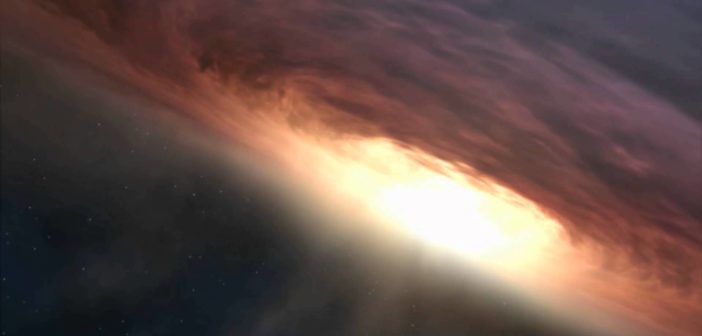How can stellar-mass black holes attain the large sizes we’ve recently observed in merging binaries? A recent study explores an intriguing possibility: perhaps these smaller black holes grow and collide while trapped within the accretion disks that can surround enormous supermassive black holes.
A Windy Mass Limit

The masses of the black holes observed by LIGO in the five confirmed black-hole mergers (and one trigger). Of the ten progenitor black holes, six exceed 20 solar masses. [LIGO/VIRGO]
The common picture of how we get stellar-mass black holes is from the evolution of massive stars. But there’s a theoretical limit to the size of a black hole that can be formed this way: massive stars lose a lot of their mass over their lifetimes due to strong stellar winds, which generally constrains them to produce black holes no larger than ~10–15 solar masses. So how did the black holes spotted with LIGO form?
Possible Explanations
One proposed source of larger stellar-mass black holes is low-metallicity stars. High-mass stars with only minimal metals (i.e., elements that aren’t hydrogen or helium) are thought to have been common in the early universe, and these stars don’t lose so much mass via stellar winds. Therefore, low-metallicity, high-mass stars could develop into larger black holes — perhaps like the black holes seen by LIGO.
A recently published study led by Shu-Xu Yi (The University of Hong Kong), however, proposes an alternative explanation for the large black-hole sizes we’ve seen — an explanation that doesn’t rely on low-metallicity environments. Yi and collaborators suggest that the key to attaining large stellar-mass black holes might be the disks of gas and dust that surround supermassive black holes in active galactic nuclei (AGN).
Trapped in a Disk

Distributions of final black-hole masses at coalescence for black-hole binaries that start out at around ~7 solar masses each in the authors’ models. A significant fraction of black holes embedded in AGN disks are able to increase their mass to more than 20 solar masses. [Yi et al. 2018]
Yi and collaborators demonstrate that a pair of black holes, each starting at only ~7 solar masses, can accrete and grow to >20 solar masses before coalescing within a low-mass AGN disk. The gravitational-wave signal from this merger could therefore indicate two black holes of perhaps 20–30 solar masses, despite the fact that the black holes were both initially much smaller.
Could this be the explanation for LIGO’s large detections? Or are low-metallicity stars the more likely progenitors? Or could both models be at work? Future detections from gravitational-wave detectors, paired with electromagnetic observations, will help us to answer these questions. In the meantime, it’s exciting to watch the field unfold.
Citation
Shu-Xu Yi et al 2018 ApJL 859 L25. doi:10.3847/2041-8213/aac649

4 Comments
Pingback: New top story on Hacker News: Growing Black Holes Within Accretion Disks – News about world
Pingback: New top story on Hacker News: Growing Black Holes Within Accretion Disks – Latest news
Pingback: New top story on Hacker News: Growing Black Holes Within Accretion Disks – World Best News
Pingback: Bookmarks for August 16th through August 17th : Extenuating Circumstances